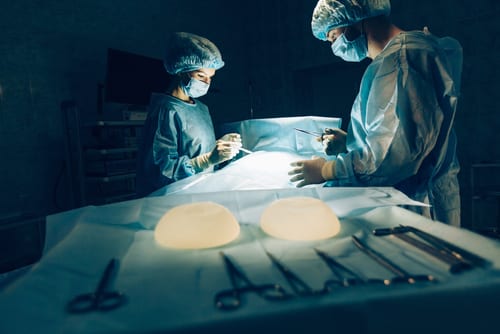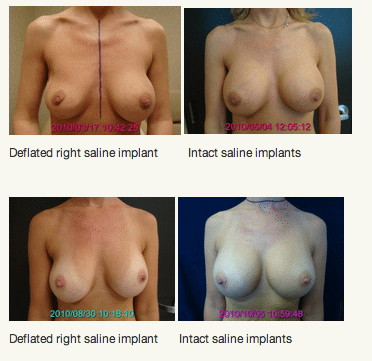Posted May 12, 2019 in Breast Revision
Breast procedures, including breast revision, are the most frequently requested procedures. In large studies, approximately 95 percent of patients are happy with their choice to undergo surgery, which makes breast augmentation one of the more successful cosmetic procedures. However, as with any other surgery, there are certainly risks, such as infection, bleeding, implant deflation, and capsular contracture.

Going Bigger
Although most women are afraid of going “too big,” many become accustomed to their new, fuller breasts and wish they had gone even larger. The downside is that this requires another surgery. However, there are several upsides:
- The procedure is generally straightforward. Dr. Friedman removes your existing implants (usually through your existing scars) and places new, larger implants.
- The results are predictably good. The existing capsules of scar tissue that surround your implant will limit further descent of the implants. What does this mean for you? More cleavage and more fullness of the upper breasts.
- The recovery is easy. We are simply doing an exchange, so the pain is limited to the site of the incision.
- You do not have to worry about the implants starting “too high.” To a large degree, what you see is what you get, as the tissues over the implants were already stretched by the previous surgery, so no further stretching is necessary.
Now let us emphasize that the upsides listed above only pertain if we make three assumptions:
- You are otherwise happy with your results. If you are dissatisfied with your implant position, breast shape, or something else about your breasts besides the size, the surgery may be more complicated.
- You are not choosing an “out-of-control” size. Remember that your body has formed capsules of scar tissue that surround and support your implants. If you choose a size that is larger than your existing scar capsules can contain, you will require a capsulotomy (surgical cut in the capsule) to make more room. While this is certainly feasible, it increases the complexity of the surgery and reduces the predictability of the results.
- Your existing breast implants have a smooth surface. Smooth implants will not “stick” to the surrounding capsule, so there is generally room for further enlargement. Textured implants do stick to the surrounding capsule, so further enlargement will require a capsulotomy.
The bottom line: assuming that a capsulotomy is not required, further enlargement of the breasts is generally a straightforward procedure with predictably good results and a smooth recovery.
Breast Revision with Larger Saline Implants
Before / After Front

Before / After (Side)

*Initial breast implants placed by another surgeon
Breast Revision with Larger Silicone Implants
Before / After (Side)
![]()
*Initial Implants placed by another surgeon.
Do Implants Have to Be Replaced Every 10 Years?
Not necessarily. All three FDA-approved US breast implant manufacturers, Allergan, Mentor®, and Sientra®, offer a 10-year limited warranty on their products. Although the warranty expires after 10 years, the implants do not.
So how long do breast implants last? No one knows for certain, but the best estimate is that most saline implants will last 10 to 15 years, and most silicone implants will last for closer to 15 to 20 years. Remember that implant longevity fits a bell-shaped curve, so some implants may deflate (saline) or rupture (silicone gel) after only a few years, whereas others may last 20 or 30 years. It’s the luck of the draw.
The important point is that your breast implants are man-made devices that will probably not last as long as you do. It is likely that your implants will need to be replaced at least once during your lifetime.
Although the manufacturer provides a limited warranty on saline breast implants, we automatically provide an extended Confidence Plus® Platinum Warranty for all of our primary saline augmentation patients. This means that if you experience a deflation within 10 years of your breast augmentation, your out-of-pocket costs to have your deflated implant replaced may be as low as zero (no surgeon fee, no surgical facility fee, no anesthesia fee, no implant fee). To our knowledge, no other plastic surgeon in the area routinely purchases the Confidence Plus® Platinum Warranty for his saline breast augmentation patients. For women undergoing breast enlargement with silicone implants, the manufacturer’s standard warranty is equivalent to the Confidence Plus® Platinum Warranty. No additional warranty is necessary.

Bottom line: If you choose to undergo breast augmentation, your implants will not have to be replaced every 10 years. But they will probably have to be replaced at some point. Make sure that you have the best warranty possible.
What Is Capsular Contracture?
Capsular contracture refers to the formation of a tight scar surrounding a breast implant following breast augmentation, which causes the implant to look or feel hard. The implant itself does not actually become hard; it just feels like it because it is being squeezed by the scar tissue.
What Causes Capsular Contracture?
When a breast implant is placed, your body recognizes it as a foreign object and builds a wall of scar tissue (capsule) around the implant to seal it off from the rest of your body. This is normal, and it’s a good thing. On a long-term basis, this capsule provides support to your implants so they don’t drop down to your belly button later in life.
The problem is that sometimes the scar tissue contracts or tightens around the implants. This may be due to a postoperative infection or bleeding problem, both of which can increase internal scarring. Most of the time there is no obvious cause—it just happens.
Risk Factors
- Capsular contracture is more common with implants placed above the muscle (subglandular implants) than those placed below the muscle (submuscular implants). It is theorized that the constant motion of the muscle over the implants keeps the capsule from tightening excessively.
- Capsular contracture is more common with silicone gel breast implants than with saline breast implants. This is likely related to the foreign—and therefore more reactive–nature of silicone gel compared to saltwater.
- Among women with subglandular implants (above the muscle), capsular contracture is more common with smooth breast implants than with textured breast implants. Surface texturing does not appear to make a significant difference if implants are placed below the muscle.
- Significant trauma to the breast can cause a small amount of bleeding around the implant, causing the scar tissue to tighten.
- Immediate postoperative infection, bleeding, or implant exposure significantly increases the risk of capsular contracture formation.
- Silicone implant rupture can cause an inflammatory reaction with silicone granuloma (small nodules adjacent to the implant) formation and/or capsular contracture.
- Saline breast implant deflation will not cause an inflammatory reaction. However, if the implant is not replaced quickly (within a few weeks), the capsule contracts in an attempt to eliminate the empty space left behind by the deflated implant.
Capsular Contracture: Grading and Treatment
We have already discussed the definition, mechanism, and risk factors for capsular contracture. Now we’ll examine the grading system and treatment.
Grading of Implant Capsules
Grade 1: There is no capsular contracture. Remember that formation of a capsule around a breast implant is expected and normal—there is a capsule surrounding every breast implant.
Grade 2: The implant looks normal but feels firm. Most women find grade 2 capsules to be reasonably acceptable. Many don’t even realize that the implant is firmer than normal.
Grade 3: The implant feels hard and looks abnormal. The capsule tries to force the implant into a spherical shape, causing the implant to stick out too much and look too narrow. The implant may look artificial or “stuck on.”
Grade 4: Same as grade 3, but the contracture is so tight that it causes breast pain.
Treatment of Capsular Contracture
Grade 1: Normal capsule. No treatment required.
Grade 2: Dr. Friedman generally recommends aggressive massage of the implants and implant displacement exercises. These involve forcefully pushing the implant up, down, and toward the midline, trying to stretch and loosen the capsule. These exercises are generally much more effective in the first six months to a year after surgery (while the implant capsule is still pliable) than after the capsule has matured. Certain medications (discussed below) may also be considered, particularly if the capsule appears to be worsening. There is no good reason to do surgery for a grade 2 capsule.
Grade 3 and 4: If sufficiently bothersome, capsular contracture may benefit from surgical management. The most common methods of surgery include capsulotomy (cutting the capsule to enable it to expand) or capsulectomy (removal of part or all of the capsule) with the placement of a new implant. For those women who would like to try nonsurgical management, there is anecdotal evidence that certain medications, including certain asthma medications, such as SINGULAIR® or ACCOLATE, or high doses of Vitamin E may lessen capsular contracture. Like breast massage, these medications tend to be most effective for relatively early issues.
If you are considering having your breast implants removed or replaced, call us at (469) 467-0100 or fill out our online contact form to schedule a consultation.